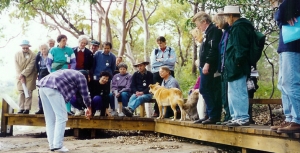Displaying items by tag: indigenous history
Caring for Country
The Aboriginal heritage of northern Sydney reminds us that these precious environments around us have been valued and nurtured for thousands of years. It reminds us that people can adapt and survive significant changes in climate. It also reminds us that some things can’t be replaced or regenerated.
It could be said that Aboriginal history has only recently gained a greater following in some parts of the wider community. Modern Australian history as a whole is quite short and it is understandable that a young society would choose to focus on the positives rather than delve into what is uncomfortable. An unfortunate consequence is that when we seek to learn more, the sources of information are fewer and less detailed.
The cataclysmic loss of life as a result of the smallpox epidemic in 1789 also meant a huge loss of traditional knowledge. The following decades of policies and attitudes that were unsympathetic towards Aboriginal people meant that the comprehensive environmental knowledge of the custodians for every tree and flower and hill and creek and bay would diminish.
Much of the work to learn about and protect Aboriginal heritage has focussed on the archaeology. The rock engravings found on Hawkesbury Sandstone platforms among Angophoras and Acacias have intrigued visitors and residents alike.
What could they mean? Macropods and marine species, boomerangs and shields, human and deity figures are represented in different areas.
Some were recorded and discussed in academic journals from the mid-1800s, with names suitable to the era, such as Mankind. A government surveyor recorded hundreds of engraving sites in the sandstone country in the late 1890s.
Throughout the twentieth century various individuals from the Australian Museum and elsewhere researched and tried to urge governments and the wider population to value and protect the engravings. Some engravings were individually protected through this and local activism, as well as the thousands that were deliberately and accidentally protected in the state and local government reserve system. The role of individual Aboriginal people in these campaigns is still poorly researched.
Then there are the rock shelters. Hawkesbury Sandstone again provided a medium for Aboriginal heritage to merge with the environment. What could be a spectacular natural landscape feature could also contain the hand stencils of family members from thousands of years ago, or the painted image of an important animal or its tracks. Even the ones we have forgotten locally, like emus and koalas.
Then there are the shell middens that shine along the now rapidly eroding foreshores of the estuaries and bays of this incredible landscape. Places where families gathered year after year to share food and stories. The middens tell us what people gathered and brought back to eat. They inform us of environmental and cultural change over time with variations in species and quantity. They invite Aboriginal people to feel welcome and connected.
Could it be said that the outsider’s interest in Aboriginal heritage and culture has been aimed in the wrong direction?
What does it matter if we record the engraved images of an animal if we have not recorded the wisdom of how to protect that species or its habitat?
Is it even fair to try to capture that wisdom but not nurture the people who have developed and implemented it over such an incredible period of the earth’s history?
We cannot go back and reinvent the past, only learn from it. Some knowledge that has been lost cannot be recaptured. A rock engraving destroyed or faded away is gone forever. However, as the bush regenerators know, the seedlings that are given the right conditions today will become tomorrow’s resilient canopy.
The climate is changing and the urban bushland is under increasing pressure. The many traditions of looking after one’s local area are more important than ever.
Our thanks go to David Watts and the friendly team at the Aboriginal Heritage Office.
Photo at top of page: David Watts with group on Sites Awareness walk, late 1990s
David Watts

